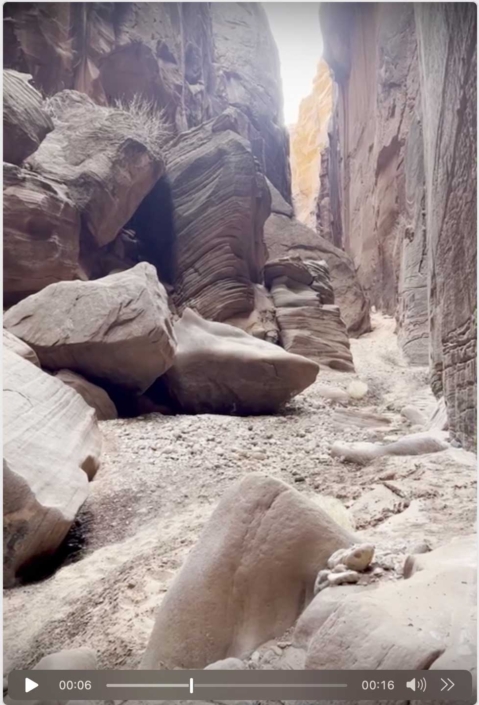Giants in the Gulch
Behind the scenes
Introduction to Buckskin Gulch
In 2020, Jason Koster went on a quick three-night backpacking trip in Paria Canyon with some friends. Paria Canyon is a slot canyon known for its towering walls, stunning visuals and numerous river crossings. The canyon starts in southern Utah and crosses into northern Arizona. Koster and his friends started at the Whitehouse Trailhead southbound and exited at Lee’s Ferry.
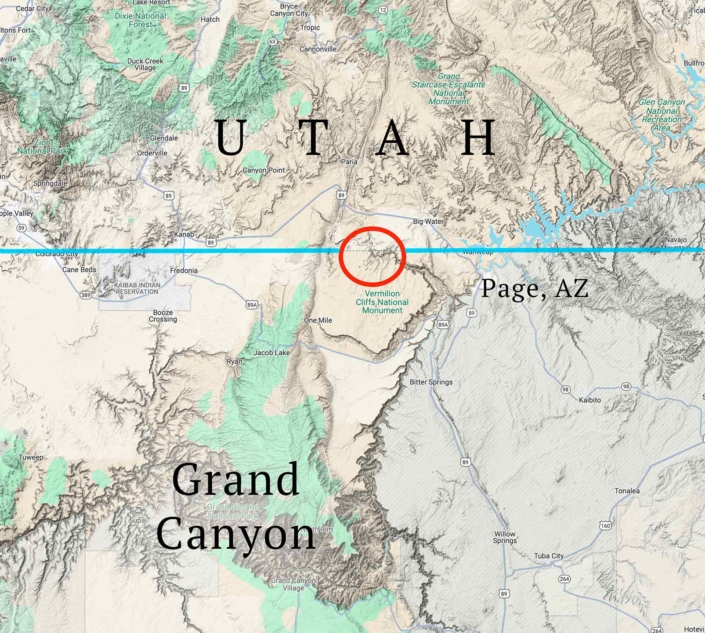
Paria Canyon is located at the Arizona-Utah border
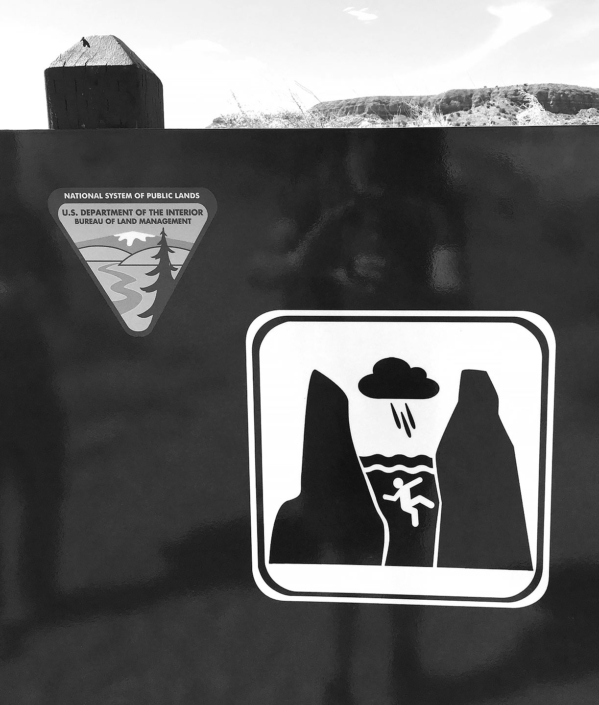
Flash flood warning before entering Paria Canyon.
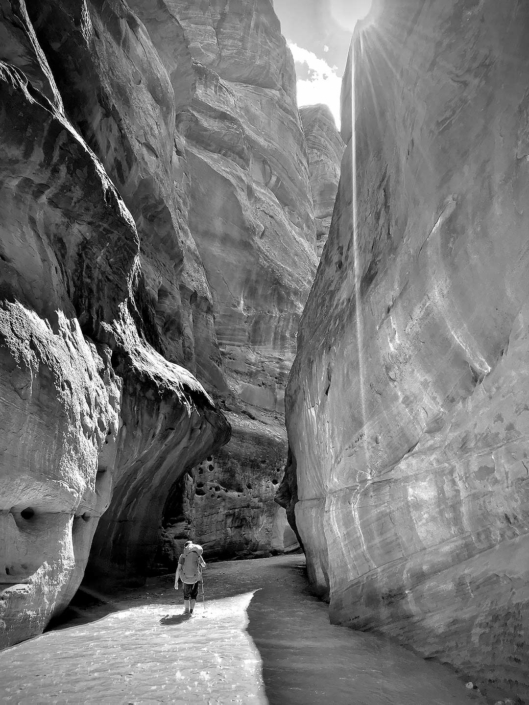
One of Koster’s many phone pics from his first experience in Paria Canyon.
On the second morning, at the Arizona-Utah border, Koster’s group took a quick detour west to experience a little bit of Buckskin Gulch – an even more dramatic slot canyon. Because Buckskin is a more narrow slot canyon there is an even greater concern for flash floods and a new element of danger, quicksand.
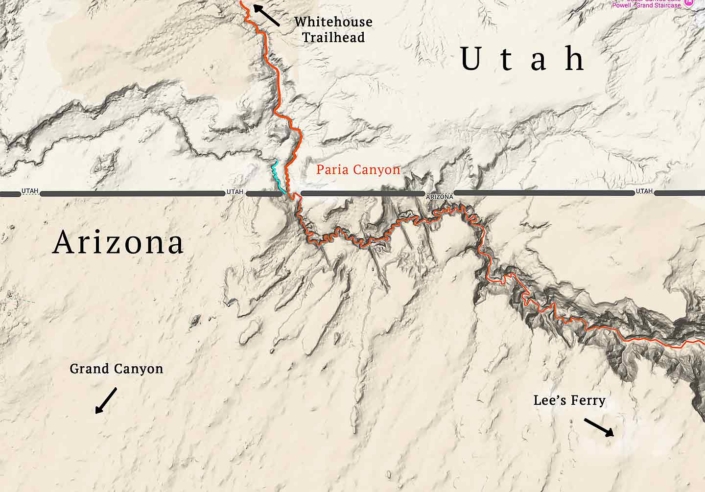
The orange line is Koster’s route from Whitehouse Trailhead out to Lee’s Ferry. The small blue line is a short detour into Buckskin Gulch.
Seeing Buckskin Gulch for the first time, Koster was convinced he wanted to return to photograph it, despite needing to be rescued from a misstep in quicksand.

Koster’s first visit to Buckskin Gulch
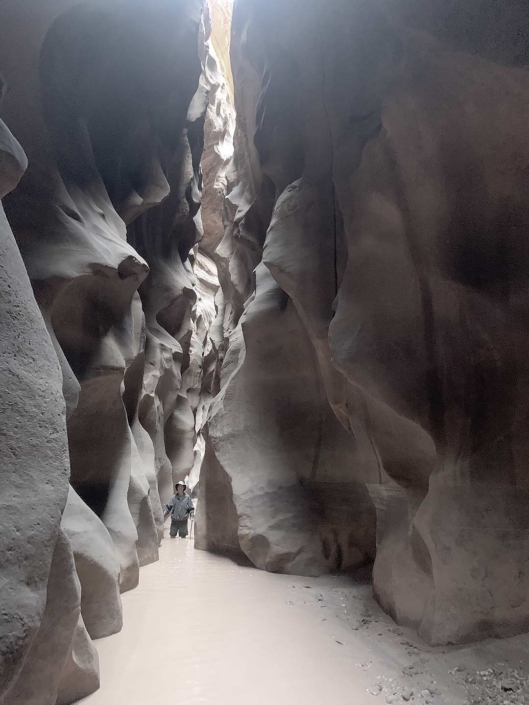
Koster in thigh deep water during his first visit to Buckskin Gulch.
Returning to Buckskin Gulch
On December 1st of 2021 Koster applied for an 8-day permit to photograph Buckskin Gulch in March of 2022. He would enter Paria Canyon from the Whitehouse Trailhead again, and it would take him one full day to reach Buckskin. Koster chose March because there is a lower probability for flash floods but the temperatures made for cold nights & mornings and cold feet standing in the river water much of the day.

Nearby temperatures but presumably colder in Buckskin Gulch because of the lack of sunlight.
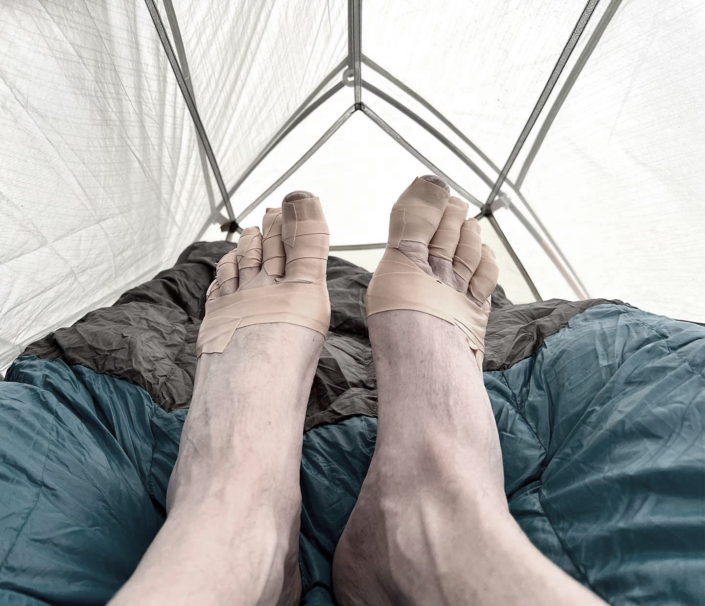
Koster prepares for standing and hiking in water all day while photographing in Buckskin Gulch by wrapping his toes in waterproof medical tape.
Camping in Buckskin Gulch is not permitted, so Koster sets up his basecamp not far from the East entrance to the gulch.
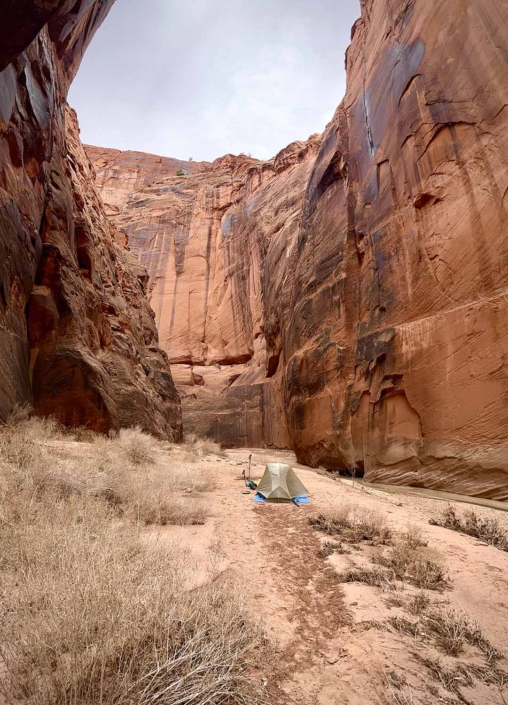
Koster’s basecamp not far away from the entrance to Buckskin Gulch.
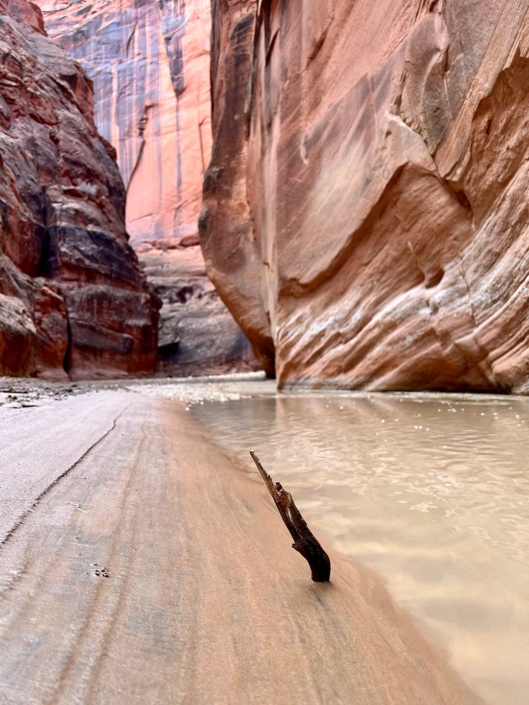
With the concern for flash floods Koster puts a marker at the waters edge of the Paria River to monitor any fluctuations that might indicate trouble.
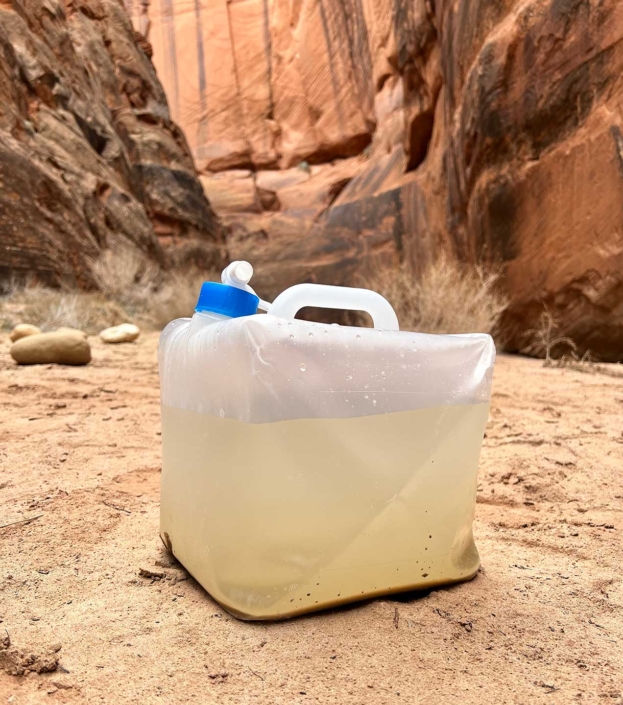
There is no reliable source of clear water in the area so Koster collected the silty river water. After a few hours the water will have separated enough to be suitable for filtering. Filtering water and collecting the next batch of water was one of the daily chores before leaving to go photograph for the day.
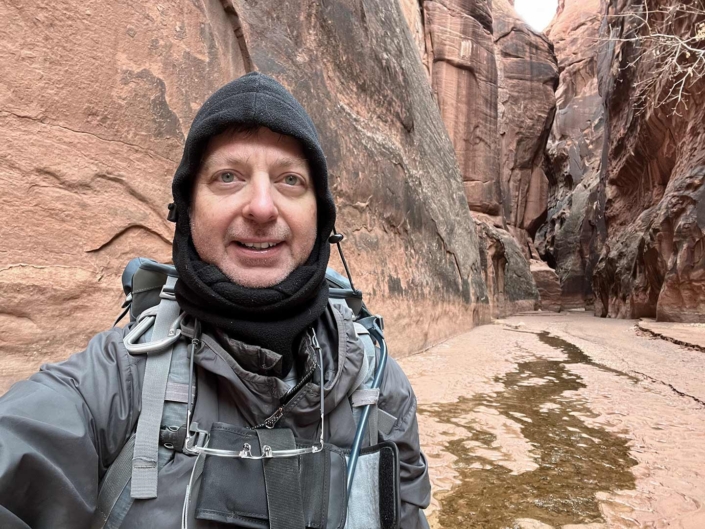
Koster after photographing the east entrance to Buckskin Gulch.

Screenshot of the map on Koster’s phone while entering Buckskin Gulch from the east. One of the last areas in the gulch with GPS service.
The Creative Instinct
The image on the left is from Koster’s phone when he was in Buckskin Gulch in 2020. It was taken on March 16th at 9:30am. The image on the right is Koster’s stitched together panoramic that he shot March 20th, 2022, 10:30am. In both of these images, the camera is facing east. At that time of the day, Koster would have been traveling west. In a 15-mile gulch Koster turned around at the same location to take almost the exact same picture two years, four days, and one hour apart. This reinforces Koster’s approach of photographing on instinct.
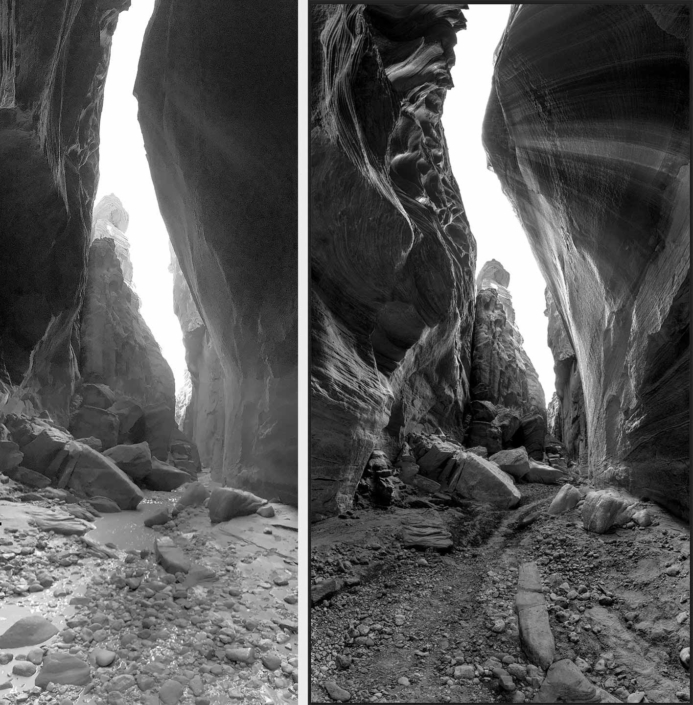
Left: Koster’s phone panoramic taken March 16th, 2020, 9:30am.
Right: Koster’s stitched image taken March 20th, 2022, 10:30am.
The Rabbit Hole
Koster: There is one spot in the gulch, about a mile or so from the East entrance with a cluster of huge boulders – the only way to pass is through a small-ish hole. I believe it has been referred to as the rabbit hole. From top to bottom was about 10-12 feet. Not terrifying but, further than you would want to fall. Twisting an ankle or a knee here would be a very unpleasant 9-miles back to the trailhead. I had read about this and showed up prepared with about 30ft of rope. Hiking into the gulch for the day to photograph I would tie each end of my rope to my pack and tripod, then put the middle of the rope in my mouth, climb up and then pull my gear up. Heading back to my camp I would lower my tripod and pack separately, pull the rope back up and then run the rope around an anchor point and rappel down. I had to go through the rabbit hole twice a day for five days on this trip.
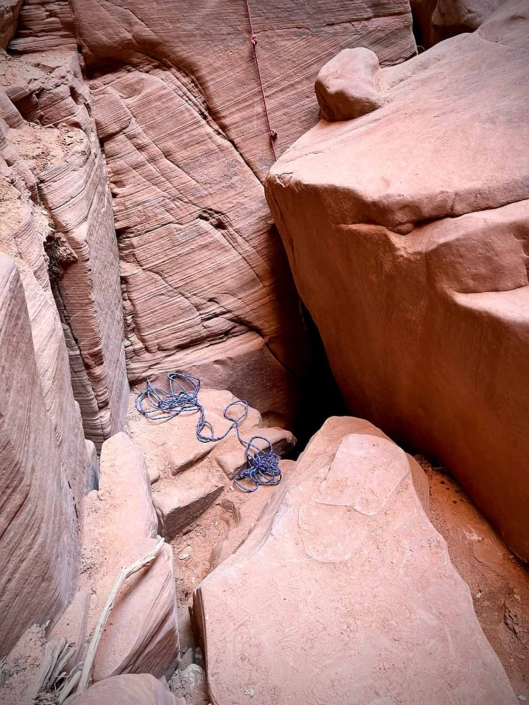
Koster’s blue rope used to him and his gear through this hole with a 10-12ft drop in Buckskin Gulch.
Flash Flood Realization
Koster: It was not uncommon to see debris wedged in the canyon walls. The first time I encountered debris I wondered how does a log get wedged way up there? Then I had the sobering realization this is from a flash flood and if I am in here during a flash flood, I am screwed. Each day as I went in further and further in the gulch I made mental notes of the few areas I might be able to scramble up and hope it was enough. I made sure to keep my wallet and keys on me at all times. Worst-case scenario: I drop my pack with my camera gear and run – hope for the best.
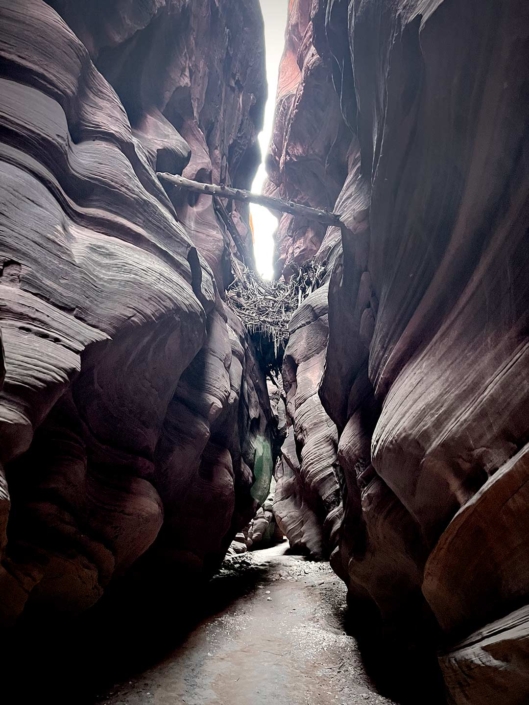
Flash flood debris wedged between the walls of Buckskin Gulch.
Saved by The Night Sky
Koster: Toward the end of a day in the gulch I felt the sun getting low in the sky and started making my way back to basecamp. On the way I saw a scene that I wanted to photograph but it was getting late. I stopped and studied the situation -given the orientation of the scene I determined this was one of the few times of day the light would look good. Against my better judgment, I quickly began to set up my camera. All the while justifying in my head, I’m here to photograph, not sit at camp. My exposures were very long and I was there longer than anticipated but, I got what I wanted. Pleased with my determination I packed up as quickly as I could and headed out at a good pace. I made it to the rabbit hole with just enough light. I am familiar with hiking in the after glow of sundown but, a couple twists and turns later and I was now in trouble. I couldn’t see. I got out my headlamp, but that was really only made for lighting something in my hands or short distances. Headlamp on or off I was pretty much blind. My pace had come to an almost stop. As I frantically scoured the blackness for anything to orient myself I eventually looked up and noticed the evening sky. The sky was brighter than the gulch. I ended up navigating my way out by looking up at the evening sky. I used my headlamp to check my distance from the walls. I know the quicksand is up against the walls. I eventually got to a point where the almost inaudible trickle of water under my shoes turned into a soft babble of water around my ankles. The black space sounded bigger. I KNOW WHERE I AM! I had reached the confluence where Buckskin meets Paria Canyon. I was hearing the Paria River. My camp was further down stream. Eventually there will be a right turn and then a little ways further again my camp would be on the left. That was all I had to go on. If I get to the left turn I have gone too far. I tried to envision the distance to my camp, was that 50 yards? 100 yards? 150 yards?? I was traveling at a snail’s pace so it felt like 1/2 a mile. Eventually my headlamp lit up the safety reflectors built into the guy lines of my tent. I was so relieved I was not going to have to spend the night in the dark away from my camp just waiting for the sun to come up enough to see. The next day I set a landmark as an exit marker. There was an area with an unusual horizontal overhang and was very easy for me to recognize. I need to be leaving this spot at 4:30 – heading back to camp at a good pace with no stopping. If I reached this spot at 2:00, I would set an alarm on my phone for one hour and fifteen minutes. An hour and fifteen minutes to explore further and an hour and fifteen minutes to get back to here by 4:30.
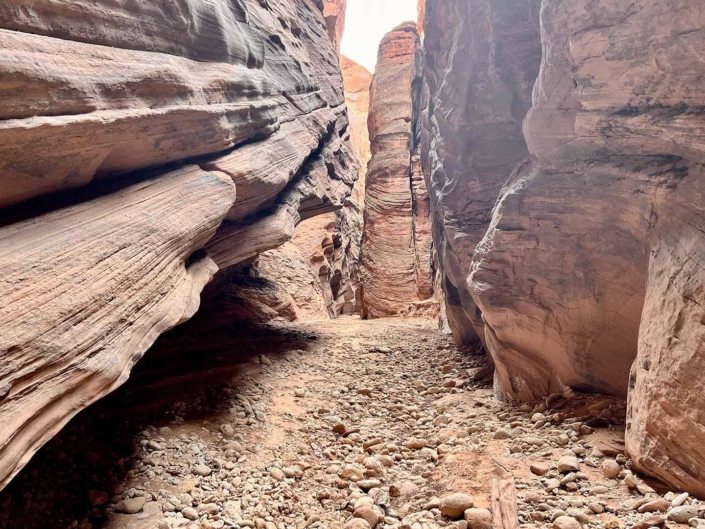
The horizontal overhang on the left is Koster’s end of day marker. He was to be heading back toward camp from this location at 4:30.

Without any GPS service in the gulch it is hard to know for certain but, the X marks the guestimation of Koster’s 4:30 heading back to camp marker.
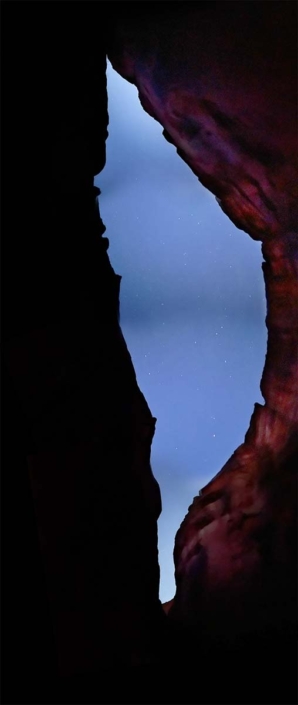
Looking up at the evening sky from within Buckskin Gulch.
Making Giants in the Gulch
Koster: My final pieces are a ‘stitched’ together composites of multiple images, on average about 30 images. Each of those images comes from a group of exposures. Because the gulch is so dark, my exposures were long. A typical sequence of exposures might be: 1″, 2″, 4″, 8″, 16″ – 31 seconds to take one of 30 frames. Add camera movements, setup & breakdown time and it was not uncommon for it to take 25 minutes to photograph a scene. The darker areas might have an exposure sequence of : 2″, 4″, 8″, 16″, 32″ – resulting in it taking closer to 40-45 minutes to photograph a scene.
In anticipation of soft, wet ground, Koster adds small metal plates to the feet of his tripod to minimize the camera sinking during long exposures.
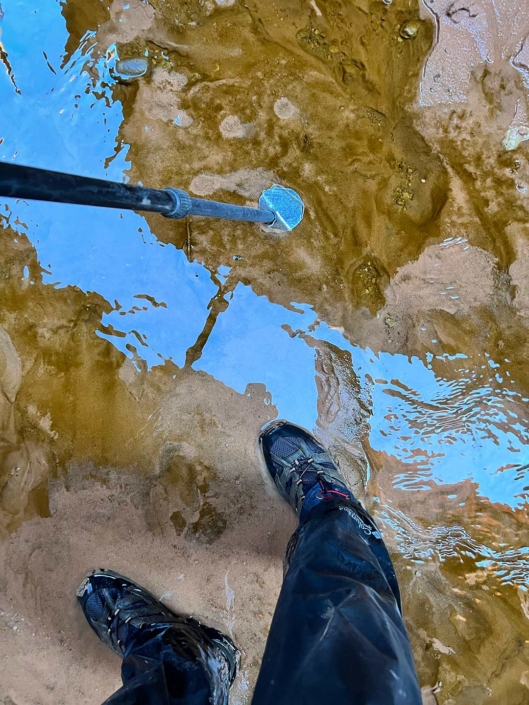
Koster attaches small metal plates to the feet of his tripod to reduce sinking during long exposures. Note the narrow reflection of the sky.
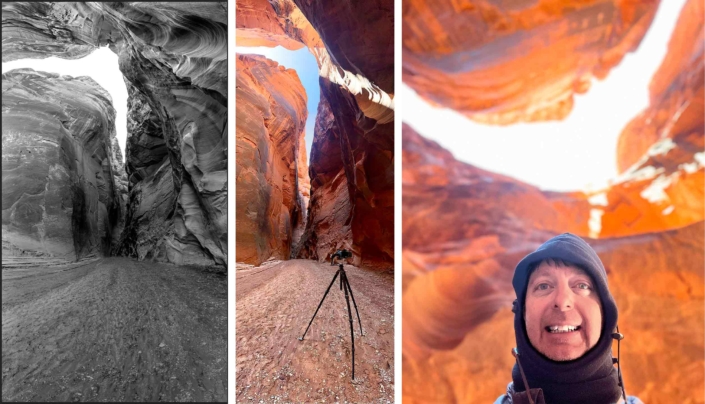
Left: One of Koster’s Giants in the Gulch finished pieces.
Middle: Behind the scenes image of Koster’s camera in Buckskin Gulch.
Right: Koster selfie looking straight up showing the gulch curve as well as how narrow it is.
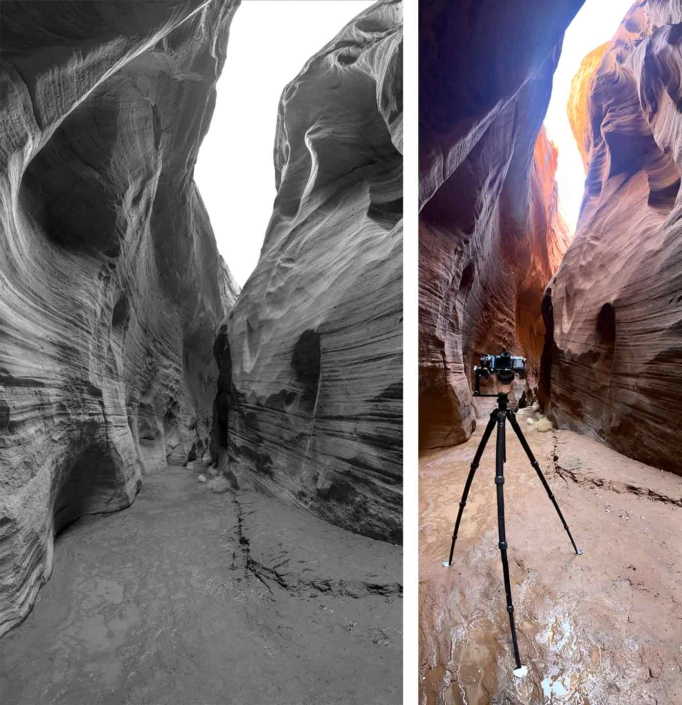
Left: Koster’s finished Giants in the Gulch finished piece.
Right: Behind the scenes shot of Koster’s camera in Buckskin Gulch.
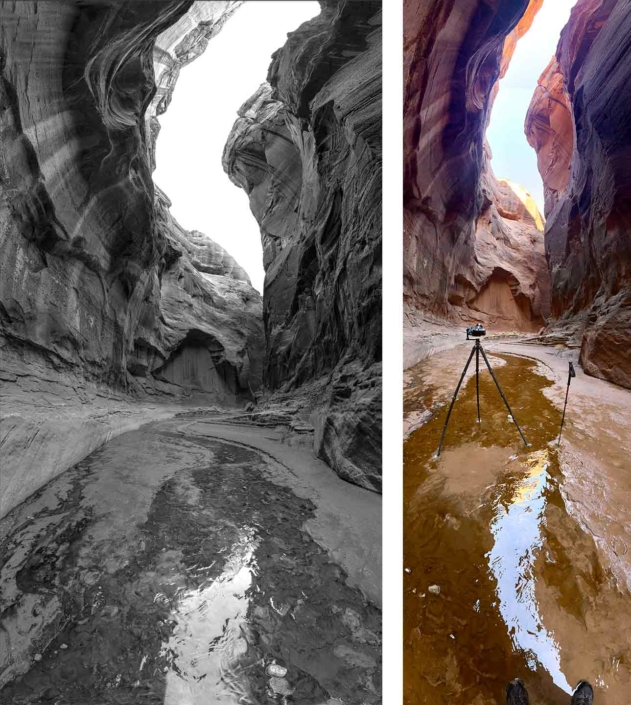
Left: Koster’s finished Giants in the Gulch finished piece.
Right: Behind the scenes shot of Koster’s camera in Buckskin Gulch.
Final Thoughts
Two more trips to Buckskin Gulch to photograph the other 11 miles is being worked out for 2026.


